|
"For the first
time (Hopewell, AD 1-400)
in eastern North America human bone becomes a widespread craft medium."---2007,
Mark F. Seeman, "Predatory War And Hopewell Trophies," The
Taking and Displaying Of human Body Parts As Trophies By Amerindians,
p. 173.
"During this same period (Hopewell)
human bone becomes an important material for the production of a variety
of standardized material forms. Some of these appear to be shamanic or
transformative in character (such as,
flutes, sucking tubes, rattles, whistles & gorgets)
while others do not."---2007,
Mark F. Seeman, "Predatory War And Hopewell Trophies," The
Taking and Displaying Of human Body Parts As Trophies By Amerindians,
p. 173.
"Most
remarkable of all the mound art are the intricate conventionalized
engravings on human bone found in the Hopewell and Turner (mound)
groups by Moorehead and Putnam."---1930,
Henry Clyde Shetrone, "The Mound-Builders" p. 131.
"Two engraved rattles
fashioned from human parietals were worn at the knees (from
burial in mound 6, Pinson Mounds) as
were several strings of ovoid shell beads."---1986,
Robert C. Mainfort, Jr., "Pinson Mounds, A Middle Woodland
Ceremonial Center," p. 70.
"Since both man and beasts of various kinds have an
important place in aboriginal mythology, it is to be expected that in
numerous instances their bones had a special sacred significance and
use---."---1912,
Frederick Webb Hodge, "Handbook Of North American Indians North Of
Mexico, Part 1," p.159.

ENGRAVED HUMAN CRANIAL
BONE
RATTLES & GORGET
ADENA AND HOPEWELL
CULTURES
WOODLAND PERIOD
The earliest evidence of human bone used as a raw material in North
America dates to the Archaic period. Several late Archaic sites have
produced evidence of trophy head taking, scalping and artifacts made
from human teeth and bone. Most of the human bone artifacts from this
period (60%) have been recovered from non-grave features. The majority
of these items are in the form of awls made from long bones. Artifacts found
in burials from this period also include drilled and notched tooth
necklaces and
bone gorgets drilled for suspension.
|
|
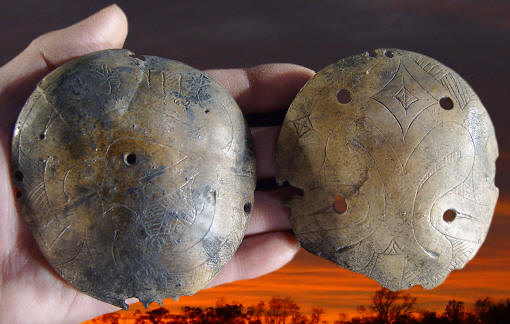
THESE ILLUSTRATED ENGRAVED RATTLES ARE
CASTS MOLDED FROM THE ORIGINAL BONE RATTLES
ORIGINAL RATTLES ARE IN THE TENNESSEE DEPARTMENT OF CONSERVATION
COLLECTION
CLICK ON PICTURE FOR LARGER IMAGE
ENGRAVED CRANIAL BONE RATTLES
PINSON MOUNDS
SITE
MADISON COUNTY, TENNESSEE
MIDDLE WOODLAND PERIOD
These engraved human bone rattles were discovered during the
excavation of Twin Mounds on the Pinson Mounds site. Each one was found at the knees of an
adult male who was approximately 45 years old. Each of these rattles
were found in pairs of circular discs that were cut from a human
cranium. Only these two discs were engraved. Luckily, the plain
halves were the least preserved of the four pieces. Each pair of
rattles are drilled at the edges where they were tied together with
thongs. Small yellow quartzite river pebbles were used to create the
sound. Several strings of ovoid shell beads were also found that may
have been attached to the rattles. These rattles measure
approximately 3 15/16 inches (10 cm) in diameter.
Pinson Mounds is a mortuary complex covering approximately 400
acres and located in Madison County, Tennessee. It's the largest
Middle Woodland period site in the southeast, dating to
approximately 200 B.C. to A.D. 400. |
|
|
The Woodland
period produced far more human bone artifacts than the previous Archaic
period. Human bone began to be used as a raw material over a wide area in the eastern United States.
Hopewell craftsmen were producing many standardized forms of artifacts,
such as flutes, sucking tubes, rattles, whistles and gorgets. Many of
these types of artifacts have been discovered in burial mounds. Hopewell
sites have produced the most prolific numbers
of skillfully crafted artifacts made from human bones. |
|
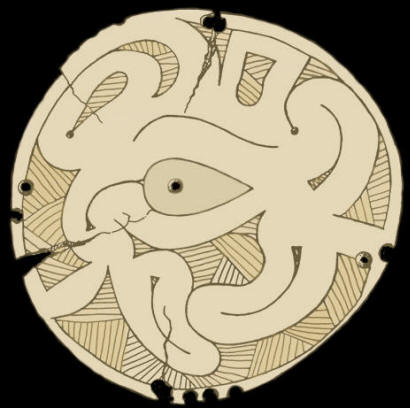
ENGRAVED CRANIAL BONE
RATTLE
PINSON MOUNDS
SITE
MADISON COUNTY, TENNESSEE
MIDDLE WOODLAND PERIOD
Both of the Pinson Mounds
rattles are engraved with highly stylized motifs that are not easy
to interpret. The main image subjects are highlighted by a
background of parallel lines that appear to represent a woven
design, like a basket. This rattle has a central design feature that
seems to indicate an eye or head and may represent one of the very
abstract images of a bird that appears on some Hopewell pots. Seeman
writes that, "Hopewell iconography is distinctive, recognizable, and
carries a shamanic caste. Dominant themes include those of human and
animal connection, ancestors, and world renewal." (Seeman 2007: 179) |
|
|
Two rare and important Hopewell culture engraved human bone rattles were
discovered during the excavation of Twin Mounds on the Pinson Mounds
site. Both were found at the knees of an
adult male who was approximately 45 years old. Pinson Mounds is a
mortuary complex covering approximately 400 acres and located in Madison
County, Tennessee. It's the largest Middle Woodland period site in the
southeast, dating to approximately 200 B.C. to A.D. 400. |
|
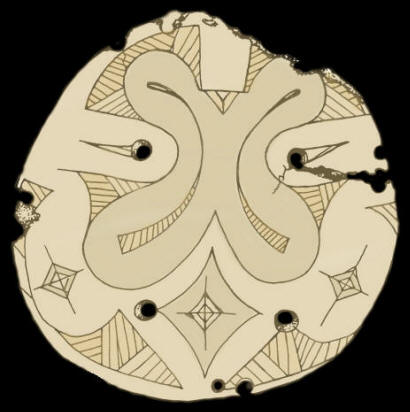
ENGRAVED CRANIAL BONE
RATTLE
PINSON MOUNDS
SITE
MADISON COUNTY, TENNESSEE
MIDDLE WOODLAND PERIOD
The design of this Pinson Mounds rattle is engraved with a highly
stylized motif. The main image is highlighted with a background of
parallel lines that appear to represent a woven design, like a
basket. One of the main design features of this rattle is a series
of three diamonds that have diamonds within diamonds and a plus sign
in the center that may indicate the four directions. |
|
|
Both of the Pinson Mounds rattles are engraved with highly stylized
motifs that are not easy to interpret. The main image subjects are
highlighted by a background of parallel lines that appear to represent a
woven design, like a basket. One of the rattles has a central design
feature that seems to indicate an eye or head and may represent one of
the very abstract images of a bird that appears on some Hopewell pots.
One of the main design features on the other rattle is a series of three
diamonds that have diamonds within diamonds and a plus sign in the
center that may indicate the four directions. Seeman writes that,
"Hopewell iconography is distinctive, recognizable, and carries a
shamanic caste. Dominant themes include those of human and animal
connection, ancestors, and world renewal." (Seeman 2007: 179) Another
pair of drilled bone discs, with a similar style of engraving were found
in the "central alter" of Turner Mound 3 in Hamilton County, Ohio. |
|
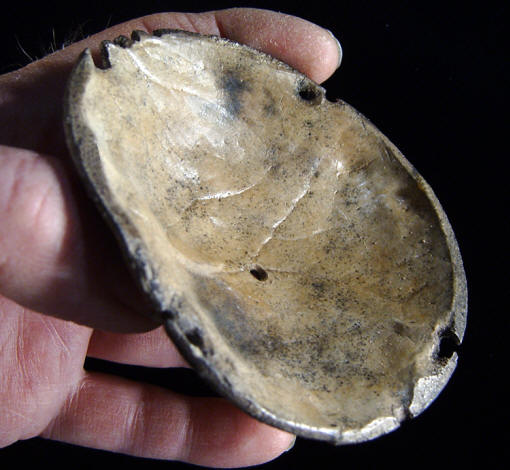
ILLUSTRATED RATTLE IS A
CAST MOLDED FROM THE ORIGINAL BONE RATTLE
ORIGINAL RATTLE IS IN THE TENNESSEE DEPARTMENT OF CONSERVATION
COLLECTION
UNDERSIDE OF ENGRAVED
CRANIAL BONE RATTLE
PINSON MOUNDS
SITE
MADISON COUNTY, TENNESSEE
MIDDLE WOODLAND PERIOD
This edge view shows the curved and concave shape of the disc that
is necessary for a rattle. |
|
|
Each of the Pinson Mounds rattles were found in pairs of circular discs
that were cut from a human cranium. Only two of the discs were engraved.
Luckily, the plain halves were the least preserved of the four pieces.
Each pair of rattles were tied together with thongs and small yellow
quartzite river pebbles were used to create the sound. Several strings
of ovoid shell beads were also found that may have been attached to the
rattles. |
|
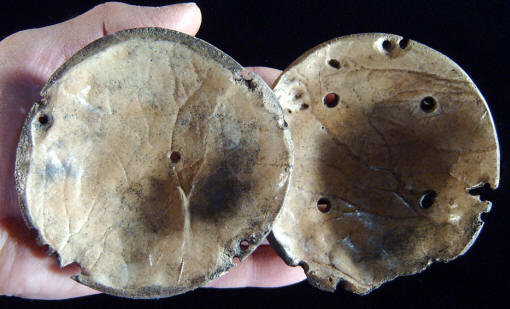
ILLUSTRATED ENGRAVED
RATTLES ARE CASTS MOLDED FROM THE ORIGINAL BONE RATTLES
ORIGINAL RATTLES ARE IN THE TENNESSEE DEPARTMENT OF CONSERVATION
COLLECTION
CLICK ON PICTURE FOR
LARGER IMAGE
UNDERSIDE OF ENGRAVED
CRANIAL BONE RATTLES
PINSON MOUNDS
SITE
MADISON COUNTY, TENNESSEE
MIDDLE WOODLAND PERIOD
This picture shows the underside of
both engraved rattles. The impression of the interior of the cranium
can clearly be seen. |
|
|
Artifacts made from human cranium have been found on late Archaic sites
in the form of cups, bowls and gorgets. Gorgets made from discs cut from
human skulls have also been found on Woodland sites. The example shown
in this article was excavated from an Adena culture infant burial in
Florence Mound located in Pickaway County, Ohio. It's described as a
"cranial ornament" and a "bone gorget decorated with bird of prey
design." Most gorgets were made of shell. They were drilled and hung
around the neck. |
|

PHOTO BY DENNIS VESPER---FROM
OHIO HISTORICAL SOCIETY COLLECTION
IMAGE IS COMPUTER ENHANCED
ENGRAVED CRANIAL BONE
GORGET
FLORENCE MOUND
PICKAWAY COUNTY, OHIO
ADENA CULTURE
This bone gorget was made
from a disc cut from the cranium of a human skull. It was excavated
from the Florence Mound in Jackston Township in Pickaway County,
Ohio. It was found with an infant burial and is described as a "bone
gorget decorated with bird of prey design." The image is a stylized
design of a raptorial bird. The surface has a textured effect like
hammered copper. The head of the bird is the main central feature
with a wing on the right side. A tail is on the left side and the
talon is forward. Two holes are drilled on opposite sides of the
circumference. The color is brownish yellow, very pale brown, very
dark brown and dark gray in color. |
|
|
The use of human bone is universal. People have been using human bones
to make both utilitarian and ritual items for thousands of years. On
Easter Island many fishhooks were made from human bone. Human bones have
been used to make items that display evidence of a victorious defeat of
an enemy in the form of war trophies and they have been used to help
retain the memory of ancestors. The subject of human bones today is
dramatic and in some ways perplexing. Ancient burials hold much of the
most important history of a culture, especially in the form of artifact
iconography and bone pathology. But sadly, these organic materials,
unlike stone, will one day be gone and with them a part of what allows
an ancient culture to live and so there in lies the dilemma. |
|
"REFERENCES"
1912, Hodge, Frederick Webb,
"Handbook Of North American Indians North Of Mexico, Part 1," p.159.
1930, Shetrone, Henry Clyde, "The Mound-Builders" p. 131.
1986, Mainfort, Robert C., Jr., "Pinson Mounds, A Middle Woodland
Ceremonial Center," p. 70.
2007,
Seeman, Mark F., "Predatory War And Hopewell Trophies," The
Taking and Displaying Of human Body Parts As Trophies By Amerindians,
pp. 167-189.
2007,
Mensforth, Robert P., "Human Trophy Taking In Eastern North America
During The Archaic Period," The
Taking and Displaying Of human Body Parts As Trophies By Amerindians,
pp. 222-277.
Personal
Communications,
Dennis Vesper
|
|
RECENT
LISTINGS HOME
ORDERING |